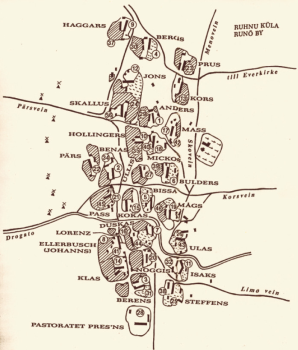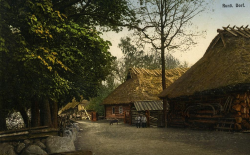Ruhnu village 



Ruhnu, a village on Ruhnu island in Ruhnu rural municipality in Saare County, 55 inhabitants (2011; 67 inhabitants in 2000).
The only village is located in the middle of the island. There is a rural municipality government, school, community center, museum, library (with the public internet access), 2 shops and 5 tourist farms in the village. The main sightseeing places in the village are the old and new church with their surrounding church yard and partially preserved old farm buildings (Korsi farm, Bulders farm and Hollingers farm).
Development
Ruhnu is an oblong-shaped clustered village in the central part of the island where farm yards are located closely to each other and curvy roads pass by between the houses. Post mills were located on the west edge of the village and churches are on the northeast edge. A granary and a small log prison were located a bit further from the village. The traditional building material was wood; for roofs reed and planks were used. In the 1920s living houses were lined with logs and painted (the so-called Swedish red), new kind of living houses were built, where a hallway with tightly divided windows decorated the entrance. In 1972, a large part of the old farm houses were destroyed during the reforms, which made the village lose its historical view. During the Soviet times, several public buildings and single-family houses were built (a power station, kolkhoz office, community and cultural centre) together with the road from the village towards the Ringsu harbour. In the beginning of the 1990s, the village had a school house, shop, post office, guesthouse, museum, library and a medical point. At the same time 8 small residentials (Mini-Priit) were also built.
History
First records of the village in the middle of the island originate from 1688 (Ruhnu on the old maps), since then until the middle of the 20th century there were old farmsteads. In the island’s west part near Utkirke, there may have been even earlier another village called Galbin (in Swedish Gamla byn, in Estonian old village). It is assumed that in 1663 there had been 29 houses or farms, exit to the sea and a lighthouse. The number of inhabitants was the highest in 1842 when 389 people lived in the village's 28 farms (20 full and 7 half farms, in addition the pastor's household). The village grew through family brunching resulting in many full farms to be divided into two. The land, buildings, fishing equipment and harvest of people active in seal fishing and fishing and to a small extent in agriculture, was still divided based on the communal principles in the first half of the 20th century. The priming of farms, where farmland distributed like patch and strip was grouped, took place in Ruhnu in 1930. After that there were 46 farms on the island.
Related articles
Created in 2013



 pere lääneküljelt, Ruhnu_S.jpg)



